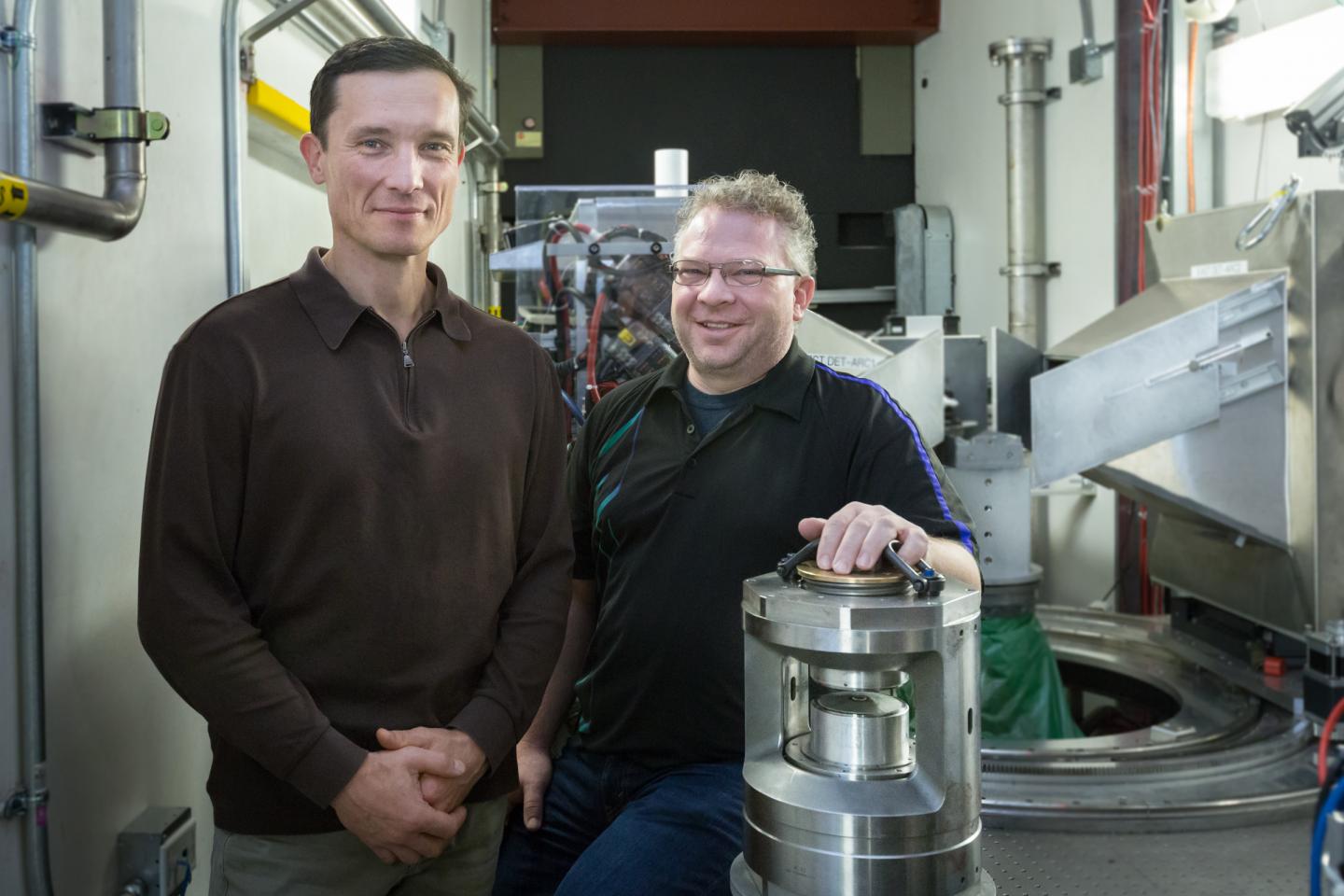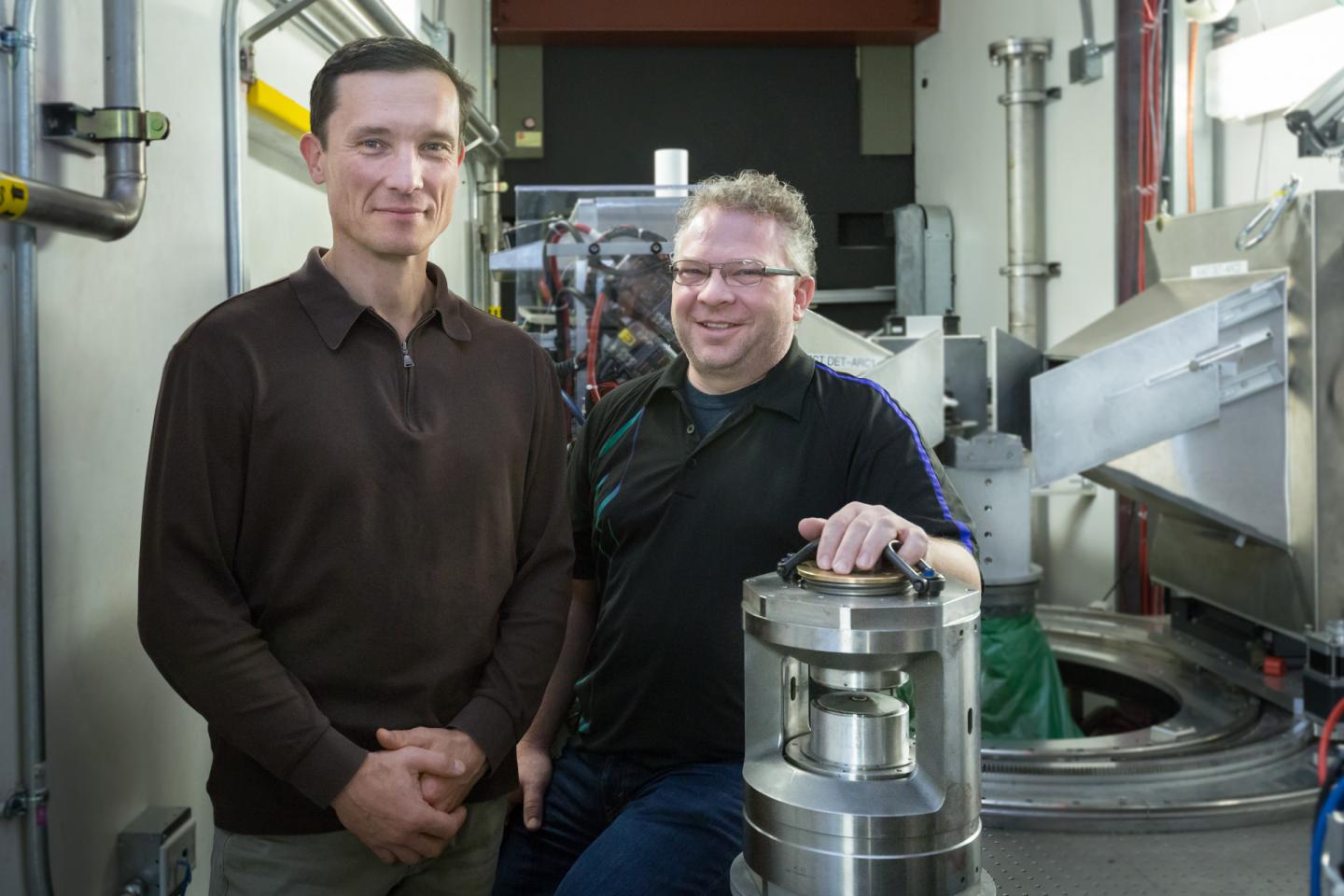
Credit: Genevieve Martin/ORNL
Unexpected results from a neutron scattering experiment at the Department of Energy's Oak Ridge National Laboratory could open a new pathway for the synthesis of novel materials and also help explain the formation of complex organic structures observed in interstellar space.
In a paper published in the journal Angewandte Chemie International Edition, the multi-institutional team of researchers, led by Haiyan Zheng from the Center for High Pressure Science and Technology Advanced Research in Beijing, formerly of the Carnegie Institution of Washington, discuss their discovery of using high pressures–rather than high temperatures–to initiate chemical reactions.
Their research will significantly improve scientists' understanding of complex carbon structures and may offer clues to the formation of amino acids from nonbiological processes.
"This discovery was somewhat of a beautiful accident," said Ilia Ivanov, a research scientist at the ORNL's Center for Nanophase Materials Sciences, a Department of Energy Office of Science User Facility.
Ivanov explains that it all began during a neutron diffraction experiment at ORNL's Spallation Neutron Source–also a DOE Office of Science User Facility. While performing a high-pressure polymerization experiment on the chemical compound acetonitrile (CH3CN) using the SNAP instrument, researchers detected the unexpected presence of ammonia. Ammonia is a colorless gas but has a very distinct odor that can be detected in even minute quantities.
"If you put acetonitrile under high pressures, you'll bring molecules together and see it reacting with itself, and eventually, it forms either a solid yellowish polymer or, as we found out, a black, carbon-rich material," Ivanov said.
Acetonitrile is one of a number of organic compounds that have been discovered in outer space and is thought to be implicated in the origins of simple amino acids, one of the basic molecules of life. In a cosmic event such as an asteroid collision, the pressures and temperatures generated can be very large, and in the presence of acetonitrile, could mimic the experiment the researchers conducted at SNAP.
The formation of the yellowish polymer was the expected result of the SNAP experiment, said SNAP instrument scientist Chris Tulk, but a surprise was just ahead.
"When the sample was depressurized and the pressure cell opened, ammonia was detected. It has a very distinct scent," Tulk said. "We thought, 'there shouldn't be ammonia in this sample right now.' So we started looking for what could have happened to first form, and then release, ammonia."
The experimental researchers then collaborated with experts in advanced electron microscopy, materials science and computing to understand the mysterious results. Based on a combination of computer simulations and microscopy, they concluded that nitrogen had left the acetonitrile sample, resulting in an enriched carbon-based material.
"The carbon material that was left was imaged using our best electron microscopes," Ivanov said. "It had onion-like layers–one shell of carbon sheet after another. So nitrogen went somewhere, but where did it go? It escaped in the form of ammonia gas."
Because a temperature-based catalyst is usually required to convert a polymer into another material, this ability to cause a chemical reaction through pressure alone is unusual.
"I wanted to continue doing these experiments to determine how much we could control the structure of a carbon material through pressure, not temperature," said Ivanov, comparing the experimental conditions with those found in household pressure cookers.
"In most cases, pressure cookers still use high temperatures to help foods cook thoroughly. But with our experiments, we've been able to use a sort of pressure cooking at room temperature, albeit at much higher pressures."
While a pressure cooker operates at 0.1 megapascals, these experiments used much higher pressures–up to 23,000 megapascals, which corresponds to the pressure found 650 kilometers below the Earth's surface at the boundary between its upper and lower mantle.
"This paper is truly exciting for us," Tulk said. "Using this process with the addition of oxygen, possibly by the addition of carbon dioxide or water into the reactants, complex carbon structures similar to the kind we suspect throughout early formation of amino acids on Earth may be realized."
The researchers note that cross-disciplinary expertise in neutron sciences and nanoscience, together with Energy Frontier Research in Extreme Environments (EFree) Center, made the research possible. EFree is a DOE Energy Frontier Research Center.
"One without the other seemed like a one-sided mission. Two aspects of research, structure and functionality, were brought together through the synergetic work. Through joint efforts like this, we continue to help users drive the discovery of new materials and new functionalities," Ivanov said.
###
Along with Zheng, Ivanov and Tulk, co-authors of the paper, "Polymerization of Acetonitrile via a Hydrogen Transfer Reaction from CH3 to CN under Extreme Conditions," include Kuo Li, Xiao Dong, Wenge Yang and Juan- Ho-kwang Mao from the Center for High Pressure Science and Technology Advanced Research in Beijing; Jamie J. Molaison, Mikhail Feygenson, Leonardo Basile and Carlos Idrobo from ORNL; Zhenxian Liu, George Cody and Malcolm Guthrie from the Carnegie Institution of Washington; and Guoying Gao from Cornell University.
Complementary investigations were conducted at DOE's Argonne National Laboratory, the Center for High Pressure Science and Technology Advanced Research in Beijing, the Departamento de Física in Ecuador, Cornell University, Rice University and the European Spallation Source.
DOE's Office of Science supported the research at Oak Ridge and EFree. Additional work was performed at the National Synchrotron Light Source, a DOE Office of Science User Facility at Brookhaven National Laboratory, at a beamline supported by NSF COMPRES and the National Nuclear Security Administration within DOE through the Carnegie/DOE Alliance Center (CDAC).
UT-Battelle manages ORNL for the DOE's Office of Science. The Office of Science is the single largest supporter of basic research in the physical sciences in the United States, and is working to address some of the most pressing challenges of our time. For more information, please visit http://science.energy.gov/.
Media Contact
Katie Bethea
[email protected]
@ORNL
http://www.ornl.gov
############
Story Source: Materials provided by Scienmag





